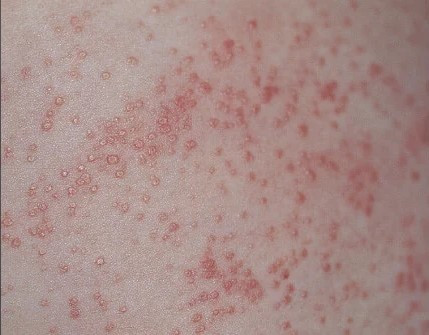Definisi
Hiperhidrosis merupakan keadaan tubuh mengeluarkan keringat secara berlebihan. Kondisi ini pada umumnya tidak berhubungan dengan suhu lingkungan yang panas ataupun karena aktivitas fisik. Selain mengganggu aktivitas sehari-hari, hiperhidrosis juga dapat menyebabkan penderitanya merasa tidak nyaman hingga mengalami masalah dalam pergaulan sosial. Kondisi ini dapat dimulai sejak masa kanak-kanak ataupun baru terlihat setelah dewasa.
Hiperhidrosis dapat terjadi pada seluruh bagian tubuh terutama pada bagian yang memiliki kelenjar keringat. Bagian yang paling sering mengalami hiperhidrosis adalah permukaan telapak tangan, permukaan telapak kaki, dan pada ketiak.
Hiperhidrosis dapat terjadi tanpa sebab yang jelas atau pun muncul sebagai akibat dari penyakit lain, seperti penyakit metabolik ataupun muncul sebagai efek samping karena penggunaan obat-obatan tertentu. Hiperhidrosis pada umumnya dapat diobati dan tidak membahayakan, hanya saja gangguan ini dapat memiliki efek jangka panjang hingga menyebabkan depresi apabila tidak ditangani dengan baik.
Pada kondisi yang paling parah, dokter akan merekomendasikan tindakan bedah. Namun, hal ini sangat jarang dilakukan. Tindakan pembedahan dapat menjadi solusi untuk mengatasi masalah produksi keringat berlebih setelah dilakukan berbagai pertimbangan.
Penyebab
Secara garis besar, kelenjar keringat terdiri atas dua jenis, yaitu kelenjar apokrin dan kelenjar ekrin. Keringat merupakan mekanisme fisiologis tubuh untuk menurunkan suhu tubuh. Sistem saraf dalam tubuh secara otomatis memicu kelenjar keringat untuk mengeluarkan keringat. Produksi kelenjar keringat berlebih bisa terjadi akibat gangguan pada sistem saraf autonom, atau berkaitan dengan penyakit tertentu.
Pada orang yang menderita hiperhidrosis tipe primer, umumnya memiliki kelenjar keringat ekrin yang hiperaktif dan memberikan sinyal berlebihan kepada kelenjar keringat. Kelenjar ekrin merupakan kelenjar keringat yang paling dominan dengan jumlah hingga empat juta kelenjar di seluruh tubuh Anda. Kelenjar ekrin banyak ditemukan pada permukaan telapak kaki, permukaan telapak tangan, kulit wajah, dan pada permukaan kulit ketiak. Kelenjar ekrin kemudian akan mengalami aktivasi karena dipicu oleh suhu tubuh yang meningkat, aktivitas fisik yang tinggi, perasaan emosional, atau akibat dari aktivitas hormonal pada tubuh.
Berbeda dengan hiperhidrosis tipe primer, penderita hiperhidrosis tipe sekunder umumnya mengalami keringat berlebih terutama pada saat sedang tertidur. Hiperhidrosis tipe sekunder disebabkan karena adanya kondisi medis khusus yang dialami oleh seseorang, atau pada orang yang sedang menjalani pengobatan tertentu. Beberapa kondisi medis yang dapat memicu terjadinya hiperhidrosis adalah diabetes, gangguan tiroid, infeksi, serangan jantung, atau gangguan sistem pernapasan. Pasien dalam pengobatan antidepresan, diabetes, atau Alzheimer juga dapat memicu terjadinya hiperhidrosis.
Faktor Risiko
Terdapat beberapa faktor yang dapat meningkatnya risiko terjadinya hiperhidrosis, beberapa diantaranya berupa:
- Diabetes,
- Gangguan pada tiroid,
- Adanya gejala hot flashes pada menopause,
- Infeksi,
- Gangguan sistem pernapasan (contohnya tuberkulosis),
- Alzheimer,
- Pasien yang sedang dalam pengobatan antidepresan.
Gejala
Kebanyakan orang berkeringat ketika sedang beraktivitas, ketika suhu tubuh meningkat atau ketika sedang mengalami stres seperti cemas. Pasien hiperhidrosis biasanya mengalami keringat berlebihan tanpa alasan khusus dan tanpa disertai penyebab tertentu. Biasanya bagian tubuh yang paling basah pada telapak tangan, telapak kaki, ketiak, atau pada area wajah dan umumnya terjadi pada kedua sisi bagian tubuh. Hal ini dikarenakan kelenjar ekrin banyak ditemukan pada permukaan telapak kaki, permukaan telapak tangan, kulit wajah, dan pada permukaan kulit ketiak.
Diagnosis
Penegakkan diagnosis pada hiperhidrosis dilakukan dengan pemeriksaan fisik mencakup pemeriksaan pada bagian tubuh yang mengeluarkan keringat berlebih. Dokter akan menanyakan beberapa pertanyaan yang dapat membantu untuk menganalisa dan memahami penyebab terjadinya keringat berlebih yang dialami pasien. Beberapa pemeriksaan khusus dapat dilakukan untuk membantu penegakkan diagnosa. Dokter akan menggunakan bedak khusus yang akan berubah warna menjadi keunguan pada saat kulit basah dan menyebabkan lapisan kulit mengelupas. Pada beberapa kasus tertentu, dokter dapat mempertimbangkan pemeriksaan tambahan lain untuk menemukan akar masalah yang menyebabkan terjadinya hiperhidrosis.
Tata Laksana
Penatalaksanaan pada kasus hiperhidrosis didasarkan pada jenis hiperhidrosis yang dialami dan letak kelenjar keringat yang mengeluarkan keringat berlebih. Dokter juga akan mempertimbangkan kondisi kesehatan Anda secara keseluruhan dan melihat faktor lain untuk mengatasi gejala hiperhidrosis yang Anda alami. Beberapa pilihan terapi yang dapat diberikan untuk membantu mengatasi gejala hiperhidrosis diantaranya antipresipiran, lonthoporesis dan obat-obatan lain terkait dengan kondisi medis tertentu.
Antipresipiran merupakan pilihan terapi yang banyak digunakan karena efektivitasnya baik dan harganya terjangkau. Antipresipiran dapat membantu untuk mengatasi keringat berlebih. Namun, harus diperhatikan bahwa pada beberapa orang dapat mengalami reaksi alergi yang menyebabkan kulit iritasi sehingga sebaiknya digunakan dengan pengawasan tenaga kesehatan.
Pilihan terapi terakhir adalah tindakan bedah. Tindakan pembedahan dilakukan apabila pasien dalam kondisi siap dan sudah mencoba berbagai terapi obat-obatan tapi tidak memberikan hasil yang efektif untuk mengatasi gejala hiperhidrosis. Semua tindakan bedah memiliki risiko sehingga pasien dan dokter harus benar-benar mempertimbangkan keputusannya sebelum memilih untuk melakukan tindakan bedah. Kebanyakan pasien dapat mengontrol gejala dengan baik setelah mengikuti anjuran dari dokter.
Komplikasi
Pada kasus hiperhidrosis, komplikasi yang dapat terjadi diantaranya berupa infeksi dan mengganggu kepercayaan diri pasien sehingga dapat mengganggu aktivitas sehari-hari ataupun dalam pergaulan di lingkungan sosial. Hiperhidrosis juga dapat menyebabkan aroma yang kurang sedap dan pada kasus yang parah, hiperhidrosis dapat menyebabkan pasien mengalami stres hingga depresi karena merasa tidak percaya diri.
Pencegahan
Beberapa cara dapat digunakan untuk mencegah terjadinya hiperhidrosis terutama menjaga kebersihan tubuh dengan mandi secara teratur. Penggunaan antipresipiran juga dapat menjadi pilihan untuk mengatasi gejala yang muncul. Selain itu, disarankan untuk menggunakan pakaian dari bahan bahan yang tidak panas sehingga memudahkan sirkulasi udara dan menekan produksi kelenjar keringat. Rutin mengganti pakaian apabila Anda mengalami hiperhidrosis agar menjaga kulit Anda tetap kering. Kenakan pakaian yang nyaman dan memiliki sirkulasi udara yang baik untuk membantu menjaga suhu tubuh agar tetap sejuk. Apabila Anda mengalami hiperhidrosis, Anda dapat mencoba teknik relaksasi seperti yoga atau meditasi untuk mengatasi stress yang dapat memicu terjadinya hiperhidrosis.
Kapan Harus Ke Dokter?
Hiperhidrosis merupakan gangguan yang tidak mengancam nyawa. Namun, hiperhidrosis dapat menyebabkan munculnya rasa tidak nyaman hingga mengganggu kualitas hidup Anda. Tidak ada ukuran pasti mengenai seberapa banyak keringat yang Anda keluarkan untuk dapat disebut sebagai hiperhidrosis. Sebaiknya Anda datang ke dokter apabila merasa tidak nyaman dengan kondisi tubuh Anda yang mengeluarkan banyak keringat sehingga mengganggu penampilan Anda.
Hiperhidrosis pada umumnya banyak dimulai dari usia remaja hingga dewasa. Kebanyakan orang mengalami produksi keringat berlebih terutama pada area telapak tangan, area telapak kaki, atau pada ketiak. Apabila lokasi keringat berlebih hanya terjadi pada ketiga area tersebut, maka disebut dengan hiperhidrosis fokal. Rata-rata pasien yang mengalami hiperhidrosis fokal tidak memiliki masalah kesehatan yang berarti. Namun, kondisi ini dapat menyebabkan masalah yang cukup serius berkaitan dengan kesehatan mental pasien dan menganggu kualitas hidup pasien. Penanganan yang tepat untuk menjaga kualitas hidup pasien.
Mau tahu informasi seputar penyakit lainnya, cek di sini ya!
- dr Anita Larasati Priyono
(Medscape, 2021) Hyperhidrosis, diakses pada 26 Maret 2022 dari Hyperhidrosis: Background, Pathophysiology, Etiology (medscape.com)
(WebMD, 2020) Excessive Sweating (Hyperhidrosis), diakses pada 26 Maret 2022 dari Hyperhidrosis (Excessive Sweating): Why It Happens & How To Treat It (webmd.com)
(MayoClinic, 2020) Hyperhidrosis, diakses pada 26 Maret 2020 dari Hyperhidrosis - Symptoms and causes - Mayo Clinic
(MayoClinic, 2020) Hyperhidrosis, diakses pada 26 Maret 2020 dari Hyperhidrosis - Diagnosis and treatment - Mayo Clinic








